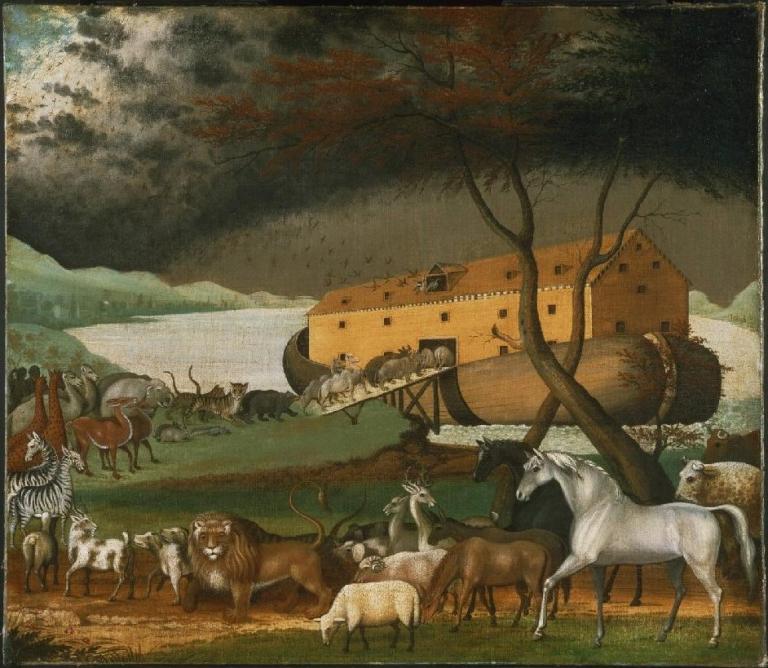
Yet another article went online today — accessible at no charge to all interested readers — in Interpreter: A Journal of Latter-day Saint Faith and Scholarship. It was written by Jeffrey Mark Bradshaw:
“The Ark and the Tent: Temple Symbolism in the Story of Noah”
Abstract: Jeffrey M. Bradshaw compares Moses’ tabernacle and Noah’s ark, and then identifies the story of Noah as a temple related drama, drawing of temple mysticism and symbols. After examining structural similarities between ark and tabernacle and bringing into the discussion further information about the Mesopotamian flood story, he shows how Noah’s ark is a beginning of a new creation, pointing out the central point of Day One in the Noah story. When Noah leaves the ark, they find themselves in a garden, not unlike the Garden of Eden in the way the Bible speaks about it. A covenant is established in signs and tokens. Noah is the new Adam. This is then followed by a fall/Judgement scene story, even though it is Ham who is judged, not Noah. In accordance with mostly non-Mormon sources quoted, Bradshaw points out how Noah was not in “his” tent, but in the tent of the Shekhina, the presence of God, how being drunk was seen by the ancients as a synonym to “being caught up in a vision of God,” and how his “nakedness” was rather referring to garments God had made for Adam and Eve.
[Editor’s Note: Part of our book chapter reprint series, this article is reprinted here as a service to the LDS community. Original pagination and page numbers have necessarily changed, otherwise the reprint has the same content as the original.
See Jeffrey M. Bradshaw, “The Ark and the Tent: Temple Symbolism in the Story of Noah,” in Temple Insights: Proceedings of the Interpreter Matthew B. Brown Memorial Conference, “The Temple on Mount Zion,” 22 September 2012, ed. William J. Hamblin and David Rolph Seely (Orem, UT: The Interpreter Foundation; Salt Lake City: Eborn Books, 2014), [Page 94]25–66. Further information at https://interpreterfoundation.org/books/temple-insights/.]
***
It’s not impossible that you may have missed one of these articles from past issues of Interpreter:
A. Keith Thompson, “The Doctrine of Resurrection in the Book of Mormon”
Abstract: The doctrine of resurrection was taught by Lehi and Jacob among the first Nephites but was not mentioned again in the record until the time of Abinadi, perhaps 350 years later. In the court of King Noah that doctrine and the idea of a suffering Messiah who would bear the sins of his people and redeem them, were heresies and Abinadi paid for them with his life. While Abinadi’s testimony converted Alma1 and the doctrine of the resurrection inspired Alma2 after his conversion, it was a source of schism in the church at Zarahemla along lines that remind us of the Sadducees at Jerusalem. The doctrine of the resurrection taught in the Book of Mormon is a precursor to the doctrine now understood by the Latter-day Saints in the light of modern revelation. One example is that the Nephite prophets used the term first resurrection differently than we do. But perhaps the most remarkable thing about the way that the doctrine of resurrection develops in the Book of Mormon, is that it develops consistently. That consistency bears further testimony to the prophetic mission of Joseph Smith. He could not have done that by himself.
Matthew L. Bowen, “Not Leaving and Going On to Perfection”
A Review of Samuel M. Brown’s First Principles and Ordinances: The Fourth Article of Faith in Light of the Temple, Provo, UT: Neal A. Maxwell Institute, 2014. 167 pp., index. $16.95.
Neal Rappleye, “Learning Nephi’s Language: Creating a Context for 1 Nephi 1:2”
Abstract: The claim that God revealed the details of Book of Mormon geography is not new, but the recent argument that there was a conspiracy while the Prophet was still alive to oppose a revealed geography is a novel innovation. A recent theory argues that the “Mesoamerican theory” or “limited Mesoamerican geography” originated in 1841 with Benjamin Winchester, an early Mormon missionary, writer, and dissident, who rejected the leadership of Brigham Young and the Twelve after 1844. This theory also claims that three unsigned editorials on Central America and the Book of Mormon published in the Times and Seasons on September 15 and October 1, 1842 were written by Benjamin Winchester, who successfully conspired with other dissidents to publish them against the will of the Prophet. Three articles address these claims. This first article addresses two questions: Did Joseph Smith, as some have claimed, know the details of and put forth a revealed Book of Mormon geography? Second, what is a Mesoamerican geography and does it constitute a believable motive for a proposed Winchester conspiracy?
Abstract: The claim that God revealed the details of Book of Mormon geography is not new, but the recent argument that there was a conspiracy while the Prophet was still alive to oppose a revealed geography is a novel innovation. A recent theory argues that the “Mesoamerican theory” or “limited Mesoamerican geography” originated in 1841 with Benjamin Winchester, an early Mormon missionary, writer, and dissident, who rejected the leadership of Brigham Young and the Twelve after 1844. This theory also claims that three unsigned editorials on Central America and the Book of Mormon published in the Times and Seasons on September 15 and October 1, 1842, were written by Benjamin Winchester, who successfully conspired with other dissidents to publish them against the will of the Prophet. Three articles address these claims. The first article addressed two questions: Did Joseph Smith, as some have claimed, know the details of and put forth a revealed Book of Mormon geography? Second, what is a Mesoamerican geography and does it constitute a believable motive for a proposed Winchester conspiracy? This second article provides additional historical background on the question of Joseph Smith’s thinking on the Book of Mormon by examining the influence of John L. Stephen’s 1841 work, Incidents of Travel in Central America, upon early Latter-day Saints, including Joseph Smith.
Steven T. Densley, “A Treasure Trove of Questions”
A review of James E. Faulconer, The New Testament Made Harder: Scripture Study Questions. The Neal A. Maxwell Institute for Religious Scholarship, 2015, 518 pages with endnotes. $21.95 (paperback).
Abstract: The New Testament Made Harder is a book that collects study questions that follow the Gospel Doctrine reading schedule. The book contains very little commentary and does not provide answers to the questions posed. The main objective is not to provide information, but rather to encourage students of the New Testament to think more deeply about what they are reading. For those who are willing to put forth the effort, they will find this book to be a helpful tool in learning to analyze the scriptures more closely.
Abstract: The crux of the creation–evolution conflict is a futile desire to scientifically prove or disprove the existence of God. The conflict is manifest in the common belief that creation means a divine, supernatural process and that evolution denotes an atheistic, accidental event. Evolution involves a random change in an inherited trait followed by selection for or against the altered trait. If humans use this principle to design machines, solve complex mathematical problems, engineer proteins, and manipulate living organisms, then certainly a super-intelligent being could have used evolution to create life on earth. This reasoning indicates that evolution does not prove atheism and that evolution is a constructive process. The theory of evolution is a mechanistic description and therefore, like all other scientific principles, is neutral on the question of God’s existence. Evolution is compatible with the simple scriptural accounts of creation. Consequently, belief or unbelief in God is put back where it should be — on individual choice.











